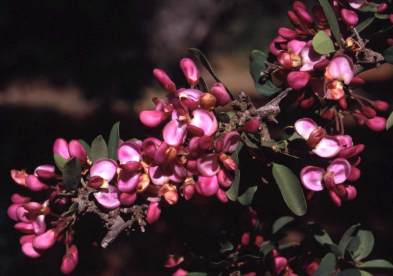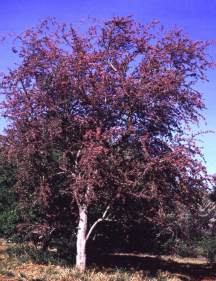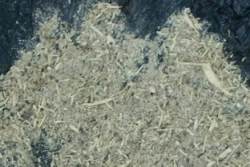Securidaca longepedunculata
Securidaca longepedunculata Fresen
Family: Polygalaceae
Common names: violet tree, fibre tree (Eng.); krinkhout , rooipeultjie, seepbasboom (Afr.); mpesu (tshiVenda); mmaba (Tswana), iphuphuma (isiZulu)
SA Tree No: 303
Introduction
Securidaca longepeduculata is a slender tree with beautiful flowers. It is a highly regarded medicinal and magical tree, especially by the vhaVenda people of the Limpopo Province where it occurs.

Description
Description
The violet tree is a small to medium-sized tree that grows up to 6 m high, with characteristic pale grey smooth bark. Leaves are variable in size and shape, alternate, often in clusters or crowded on dwarf spur branchlets which are sometimes spine-tipped. They have very fine hairs when young but they lose them as they mature. Flowers are sweetly scented, in short bunches, pink to purple and are produced in early summer. They are about 10 mm long and are each borne on a long, slender stalk (peduncle). Terminal and axillary sprays are about 30-50 mm long, appearing with the very young leaves. The fruit is round, with a distinctive membranous wing up to 40 mm long, purplish green when still young, becoming pale straw-coloured, and can be seen between April and August.

Conservation Status
Status
Securidaca longipedunculata is a threatened and protected species. It is used for medicinal purposes and other uses in rural areas. What makes it so threatened is the fact that the roots are the target for people using this plant, which makes it difficult for the plant to survive constant harvesting.
Distribution and habitat
Distribution description
It occurs in the North-West and Limpopo provinces of South Africa, in Mozambique and is widely distributed in tropical Africa. The violet tree is found in woodland and arid savanna soils.
Derivation of name and historical aspects
History
The generic name comes from a Latin word securis meaning hatchet, referring to the shape of the nut with its curved membranous wing; and longipedunculata which refers to the long peduncle.
Ecology
Ecology
It is very attractive to birds, butterflies and insects especially when in flower.

Uses
Use
The violet tree is the most popular of all the traditional medicinal plants in South Africa and is used for almost every conceivable ailment. The roots are extremely poisonous, smell like wintergreen oil and contain methyl salicylate which may partly indicate why they have a wide diversity of uses, such as arrow poison in some parts of Africa including West Africa.

The roots and bark are taken orally either powdered or as infusions for treating chest complaints, headache, inflammation, abortion, ritual suicide, tuberculosis, infertility problems, venereal diseases and for constipation. Toothache can also be relieved by chewing the roots. Mixed roots of the violet tree and dwarf custard apple are used to treat gonorrhea. Powdered roots or wood scrapings are used to treat headache by rubbing them on the forehead, while infusions from the roots are used to wash tropical ulcers. In Limpopo, the vhaVenda people use roots for mental disorders and as protection against children's illness during breastfeeding. It is also believed that many African people use the powdered violet tree roots as a sexual boost for men. The vhaVenda people mix the powdered root with mageu (maize or sorghum beverage) and it is given to a man to drink if he is sexually weak.
The bark is used to make soap, fibre for fishing nets, baskets and strong threads that are used to sew bark cloth. In Zimbabwe, the roots are used to treat people who are believed to be possessed by evil spirits, for snakebite as well as for coughs when pounded with water and salt.
Growing Securidaca longepedunculata
Grow
The violet tree is difficult to cultivate, although some writers recommend that the seeds should be soaked thoroughly and then be planted in a sandy soil where the plants will remain, as they do not like to be disturbed. This tree can also be propagated by taking cuttings of the root shoots, as it does not grow well when transplanted.
References
- Hutchings, A. 1996. Zulu medicinal plants. An inventory. University of Zululand , Scottsville, South Africa.
- Schimidt, E., Lotter, M. & McCleland, W. 2002. Trees and shrubs of Mpumalanga and Kruger National Park . Jacana Publications, Houghton, Johannesburg.
- Van Wyk, A.E. & Van Wyk, P. 1998. Field guide to trees of southern Africa . Struik, Cape Town.
- Van Wyk, A.E., Van Wyk, P. & Van Wyk, B-E. 2000. Photographic guide to trees of southern Africa . Briza Publications, Pretoria.
- Van Wyk, B-E. & Gericke, N. 2000. A guide to useful plants of southern Africa . Briza Publications Pretoria.
- Van Wyk, B-E., Van Oudtshoorn, B. & Gericke, N. 1997. Medicinal plants of South Africa : Briza Publications, Pretoria.
Credits
Avhurengwi Phillemon Ndou
Walter Sisulu National Botanical Garden
August 2006
Plant Attributes:
Plant Type: Tree
SA Distribution: North West
Soil type: Sandy, Loam
Flowering season: Early Summer
PH: Acid, Neutral
Flower colour: Pink
Aspect: Full Sun
Gardening skill: Challenging
Special Features:
Horticultural zones







Rate this article
Article well written and informative
Rate this plant
Is this an interesting plant?
Login to add your Comment
Back to topNot registered yet? Click here to register.